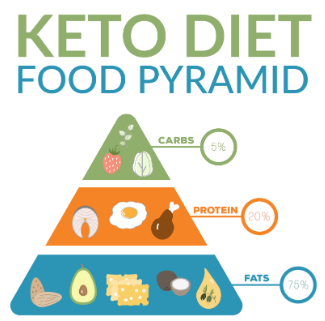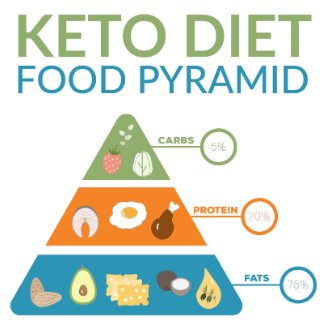Explaining KETO diet to a 7th Grader
Posted by Just Fitter on
Are you on a diet or did you ever consider dieting? Then you know just how confusing it can be with all the conflicting advice. But it doesn’t have to be so complicated. We must understand that being on a diet takes discipline and some diet strategy may work better for you than them. So here is another interesting type of diet that might just work for you…
What is really a KETO diet? KETO or KETOGENIC diet is an effective way to lose weight, lower risk factors for disease and has a lot of benefits to a variety of health conditions. But before going thru this diet, let us explain to you the essential terms in undergoing a KETO diet which are -- calories and carbohydrates.
Calories. Calories for some are “the thing in food that makes us fat.” By definition, a calorie is the energy it takes to raise the temperature of 1 kilogram of water 1 degree Celsius. The important word to take away from this definition is ENERGY. Calories are ENERGY that fuel our bodies- much like gasoline fuels our cars. Without sufficient calories our heart would not beat, our lungs would not function, and our brain would not work. Many people underestimate how many calories our body needs just to exist.
An adult body needs to have enough energy to fuel key organs like the brain, heart, and lungs at rest. This minimum number of calories is called your resting metabolic rate (RMR) and it varies greatly depending on age, sex, weight, and muscle mass. However, in order to have enough energy to live your day and be active, you need more energy than what’s required from your resting metabolic rate (RMR). This extra energy typically amounts to about 400 to 600 additional calories per day (which can be even higher depending on activity level) and is the energy you need to move and fuel your fitness, versus just lying still all day.
If you exceed the number of calories your body requires each day you will eventually gain weight. For example, if your body needs 2,000 calories a day to maintain its current weight, and every day you consume 2,500 calories, in one week you would gain 1 lb.
Carbohydrates. Carbohydrates often get a bad rap, especially when it comes to weight gain. But carbohydrates aren't all bad. Because of their numerous health benefits, carbohydrates have a rightful place in your diet. In fact, your body needs carbohydrates to function well. Relating to calories, Calorie is a unit of energy that comes from three main sources: one of which is carbohydrates, the other two are proteins and fats.
So, what are the role of these terms in Keto diets? The ketogenic diet is a very low carb, high fat diet. It involves drastically reducing carbohydrate intake and replacing it with fat. If you follow a standard high-carb diet, your cells use glucose as their main energy source, which comes from the carbs in your diet, including sugars and starchy foods like bread, pasta and vegetables. But if you limit or avoid these foods — such as when you’re on a keto diet — your body doesn’t have enough glucose to meet its energy needs. This means it must look for alternative fuel sources. Your body does this by breaking down stored fat into fatty acids and ketones. These ketones replace glucose and supply most of the energy your brain needs.

The one thing that sets the ketogenic diet apart from other diets is the fact that one of its primary goal is to get you into ketosis and sustain those ketone levels while you are dieting. This type of dietary approach can provide us many benefits such as increased fat loss, improved cognitive function, and reduced hunger.
However, to experience the power of ketosis, our body will go through many changes. These changes may be unpleasant, but they will also provide us with signs that we are entering ketosis.
How to Tell If You Are in Ketosis
 |
1. Dry Mouth and Increased Thirst The combination of carb restriction and ketone production will cause your body to lose water at a rapid rate. If you are not drinking enough water during this process, you will typically have dry mouth and increased thirst. |
 |
2. Bad Breath As your body is acclimating to ketone production, acetone will tend to spontaneously form. Since it can’t be used a fuel by our cells, we excrete it from the body in the urine and through our breath. This is why many keto dieters will have bad breath or “keto breath” that will sometimes smell sharp and pungent like overripe fruit or nail polish remover. |
 |
3. Increased Urination Carbohydrate restriction and ketones are both natural diuretics. When you first start keto dieting, you may have more frequent bathroom trips as your body’s insulin levels decrease and you release more water and sodium as a result. After a couple of days, the bathroom trips may continue as you start to produce more ketones. |
 |
4. Reduced Hunger and Appetite Suppression The ketogenic diet is one of the best diets for reducing hunger and causing people to eat fewer calories without realizing it. In many ways the keto diet is the perfect recipe for weight loss — it focuses on highly satiating whole foods like meat, fish, cheese, and low carb vegetables while also stimulating the body to use fuel sources (like ketones) that are more efficient than sugar. |
 |
5. Digestive Issues
|
 |
6. Short-Term Fatigue Before your liver starts increasing ketone production and you experience the benefits of ketosis, you may experience a decrease in physical and mental performance. This is one of the keto conundrums that can occur during your first week of keto dieting. |
 |
7. Insomnia Insomnia or lack of sleep may be experienced when you are first adapting to keto dieting. You may find that you are struggling to fall asleep, waking up in the middle of the night, and/or not getting a full nights rest. |
 |
8. Increased Focus and Energy Once your body starts burning more ketones for fuel, you will need less and less sugar and your energy levels will be more stable throughout the day. This may manifest itself as a newfound capacity to focus for extended periods of time or the ability to make it through the day with an afternoon coffee or nap. The efficiency of burning ketones and fat for fuel will be a saving grace for many of us who struggle to make it through the week. |
 |
9. Weight Loss Although ketosis is not necessary for weight loss to occur, losing weight rapidly while restricting carbs is still a good sign that you are on the path to ketosis. While you are on the ketogenic diet, you will typically lose a couple of pounds of water weight along with some fat in the first week. This shows you that your insulin levels are dropping significantly, setting your body up for ketone production. |
Using urine strips when you’re just starting a keto diet is an easy and affordable way to see if your ketone levels are rising.

Most of the time, you’ll be looking for changes in color on the strip and comparing the results to a color chart that comes with the kit. Light pink means the level of ketones in your urine is low, while dark purple means the opposite.
Conclusion:
A keto diet is high in fat, moderate in protein and very low in carbs. It does not only help you lose weight but it has several health benefits as well.
Ketone strips have become increasingly popular as a way for people following a keto diet to check whether they’re in ketosis.
There are two types of keto strips: urine and blood.
Urine strips are ideal if you’re new to the keto diet and want an easy and affordable way to ensure you’re headed towards ketosis.
Once your body has become keto-adapted, blood strips are more accurate but also more expensive. In either case, the strips can help you monitor and adjust your diet accordingly to get into and maintain a level of ketosis.
Nonetheless, the ultimate goal of any kind of diet is to be healthy and to stay that way for our entire lifetime. Therefore, we must always practice Self-care – that is looking after our own health using the knowledge and information available. It is a decision-making process that empowers us to look after our own health efficiently and conveniently, in collaboration with health and social care professionals as needed.
References:
- https://www.superkidsnutrition.com/nw_what-is-a-calorie/
- https://www.healthydrivenchicago.com/weight-loss/six-successful-diet-strategies/
- https://www.healthline.com/nutrition/ketogenic-diet-101#other-benefits
- https://www.mayoclinic.org/healthy-lifestyle/nutrition-and-healthy-eating/in-depth/carbohydrates/art-20045705
- 10SignsOfKetosis:HowToKnowIfYouAreInKetosis(ruled.me)
- https://www.healthline.com/nutrition/keto-strips#bottom-line
- https://www.selfcarefederation.org/what-is-self-care
- https://blog.kissmyketo.com/articles/keto-diet-basics/measuring-ketosis-a-quick-guide-to-ketone-strips/
- https://www.verywellhealth.com/how-to-test-your-urine-for-ketones-2241626










